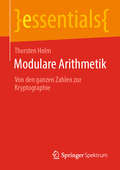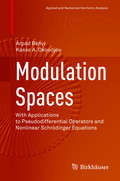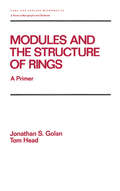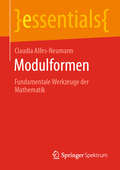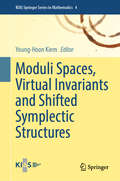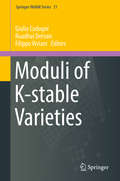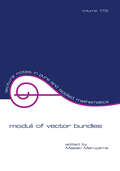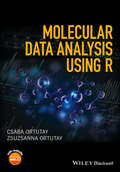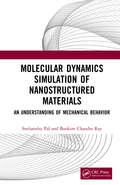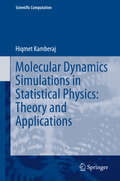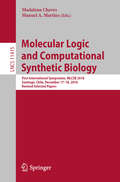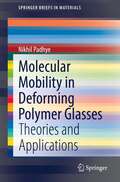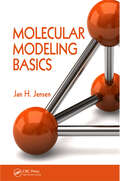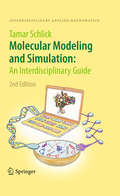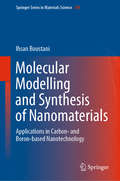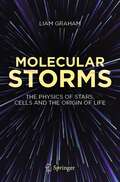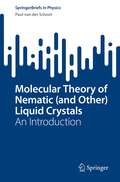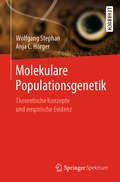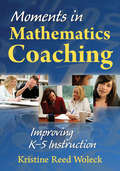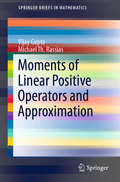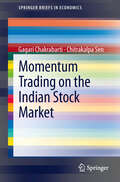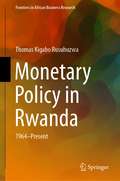- Table View
- List View
Modulare Arithmetik: Von den ganzen Zahlen zur Kryptographie (essentials)
by Thorsten HolmDieses essential bietet eine Einführung in die modulare Arithmetik, die mit wenig Vorkenntnissen zugänglich und mit vielen Beispielen illustriert ist. Ausgehend von den ganzen Zahlen und dem Begriff der Teilbarkeit werden neue Zahlbereiche bestehend aus Restklassen modulo einer Zahl n eingeführt. Für das Rechnen in diesen neuen Zahlbereichen wichtige Hilfsmittel wie der Euklidische Algorithmus, der Chinesische Restsatz und die Eulersche φ-Funktion werden ausführlich behandelt. Als Anwendung der modularen Arithmetik werden zum Abschluss die Grundzüge des für viele moderne Anwendungen grundlegenden RSA-Verschlüsselungsverfahrens präsentiert.
Modulation Spaces: With Applications to Pseudodifferential Operators and Nonlinear Schrödinger Equations (Applied and Numerical Harmonic Analysis)
by Kasso A. Okoudjou Árpád BényiThis monograph serves as a much-needed, self-contained reference on the topic of modulation spaces. By gathering together state-of-the-art developments and previously unexplored applications, readers will be motivated to make effective use of this topic in future research. Because modulation spaces have historically only received a cursory treatment, this book will fill a gap in time-frequency analysis literature, and offer readers a convenient and timely resource.Foundational concepts and definitions in functional, harmonic, and real analysis are reviewed in the first chapter, which is then followed by introducing modulation spaces. The focus then expands to the many valuable applications of modulation spaces, such as linear and multilinear pseudodifferential operators, and dispersive partial differential equations. Because it is almost entirely self-contained, these insights will be accessible to a wide audience of interested readers.Modulation Spaces will be an ideal reference for researchers in time-frequency analysis and nonlinear partial differential equations. It will also appeal to graduate students and seasoned researchers who seek an introduction to the time-frequency analysis of nonlinear dispersive partial differential equations.
Modules and the Structure of Rings: A Primer (Pure and Applied Mathematics #147)
by Tom Head Jonathan S. Golan<p>This textbook is designed for students with at least one solid semester of abstract algebra,some linear algebra background, and no previous knowledge of module theory. <i>Modules and the Structure of Rings</i> details the use of modules over a ring as a means of considering the structure of the ring itself--explaining the mathematics and "inductive reasoning" used in working on ring theory challenges and emphasizing modules instead of rings. <p>Stressing the inductive aspect of mathematical research underlying the formal deductive style of the literature, this volume offers vital background on current methods for solving hard classification problems of algebraic structures. Written in an informal but completely rigorous style, Modules and the Structure of Rings clarifies sophisticated proofs ... avoids the formalism of category theory ... aids independent study or seminar work ... and supplies end-of-chapter problems.This book serves as an excellent primary.text for upper-level undergraduate and graduate students in one-semester courses on ring or module theory-laying a foundation for more advanced study of homological algebra or module theory.</p>
Modulformen: Fundamentale Werkzeuge der Mathematik (essentials)
by Claudia Alfes-NeumannClaudia Alfes-Neumann behandelt in diesem essential Anwendungen der Theorie der Modulformen und ihre Bedeutung als grundlegende Werkzeuge in der Mathematik. Diese – zunächst rein analytisch definierten – Funktionen treten in sehr vielen Bereichen der Mathematik auf: sehr prominent in der Zahlentheorie, aber auch in der Geometrie, Kombinatorik, Darstellungstheorie und der Physik. Nach der Erläuterung notwendiger Grundlagen aus der komplexen Analysis definiert die Autorin Modulformen und zeigt einige Anwendungen in der Zahlentheorie. Des Weiteren greift sie zwei wichtige Aspekte der Theorie rund um Modulformen auf: Hecke-Operatoren und L-Funktionen von Modulformen. Den Abschluss des essentials bildet ein Ausblick auf reell-analytische Verallgemeinerungen von Modulformen, die in der aktuellen Forschung eine bedeutende Rolle spielen.
Moduli Spaces
by Leticia Brambila-Paz Oscar García-Prada Peter Newstead Richard P. ThomasModuli theory is the study of how objects, typically in algebraic geometry but sometimes in other areas of mathematics, vary in families and is fundamental to an understanding of the objects themselves. First formalised in the 1960s, it represents a significant topic of modern mathematical research with strong connections to many areas of mathematics (including geometry, topology and number theory) and other disciplines such as theoretical physics. This book, which arose from a programme at the Isaac Newton Institute in Cambridge, is an ideal way for graduate students and more experienced researchers to become acquainted with the wealth of ideas and problems in moduli theory and related areas. The reader will find articles on both fundamental material and cutting-edge research topics, such as: algebraic stacks; BPS states and the P = W conjecture; stability conditions; derived differential geometry; and counting curves in algebraic varieties, all written by leading experts.
Moduli Spaces, Virtual Invariants and Shifted Symplectic Structures (KIAS Springer Series in Mathematics #4)
by Young-Hoon KiemEnumerative geometry is a core area of algebraic geometry that dates back to Apollonius in the second century BCE. It asks for the number of geometric figures with desired properties and has many applications from classical geometry to modern physics. Typically, an enumerative geometry problem is solved by first constructing the space of all geometric figures of fixed type, called the moduli space, and then finding the subspace of objects satisfying the desired properties. Unfortunately, many moduli spaces from nature are highly singular, and an intersection theory is difficult to make sense of. However, they come with deeper structures, such as perfect obstruction theories, which enable us to define nice subsets, called virtual fundamental classes. Now, enumerative numbers, called virtual invariants, are defined as integrals against the virtual fundamental classes. Derived algebraic geometry is a relatively new area of algebraic geometry that is a natural generalization of Serre’s intersection theory in the 1950s and Grothendieck’s scheme theory in the 1960s. Many moduli spaces in enumerative geometry admit natural derived structures as well as shifted symplectic structures. The book covers foundations on derived algebraic and symplectic geometry. Then, it covers foundations on virtual fundamental classes and moduli spaces from a classical algebraic geometry point of view. Finally, it fuses derived algebraic geometry with enumerative geometry and covers the cutting-edge research topics about Donaldson–Thomas invariants in dimensions three and four.
Moduli of K-stable Varieties (Springer INdAM Series #31)
by Filippo Viviani Giulio Codogni Ruadhaí DervanThis volume is an outcome of the workshop "Moduli of K-stable Varieties", which was held in Rome, Italy in 2017. The content focuses on the existence problem for canonical Kähler metrics and links to the algebro-geometric notion of K-stability. The book includes both surveys on this problem, notably in the case of Fano varieties, and original contributions addressing this and related problems. The papers in the latter group develop the theory of K-stability; explore canonical metrics in the Kähler and almost-Kähler settings; offer new insights into the geometric significance of K-stability; and develop tropical aspects of the moduli space of curves, the singularity theory necessary for higher dimensional moduli theory, and the existence of minimal models. Reflecting the advances made in the area in recent years, the survey articles provide an essential overview of many of the most important findings. The book is intended for all advanced graduate students and researchers who want to learn about recent developments in the theory of moduli space, K-stability and Kähler-Einstein metrics.
Moduli of Vector Bundles (Lecture Notes In Pure And Applied Mathematics Ser.)
by Masaki Maruyama"Contains papers presented at the 35th Taniguchi International Symposium held recently in Sanda and Kyoto, Japan. Details the latest developments concerning moduli spaces of vector bundles or instantons and their application. Covers a broad array of topics in both differential and algebraic geometry."
Moja Means One: A Swahili Counting Book
by Muriel L. FeelingsA counting book that portrays the life and culture of Swahili-speaking Africa, with a brief text and dramatic illustrations. The numbers one through ten in Swahili accompany two-page illustrations of various aspects of East African life.
Molecular Data Analysis Using R
by Csaba Ortutay Zsuzsanna OrtutayThis book addresses the difficulties experienced by wet lab researchers with the statistical analysis of molecular biology related data. The authors explain how to use R and Bioconductor for the analysis of experimental data in the field of molecular biology. The content is based upon two university courses for bioinformatics and experimental biology students (Biological Data Analysis with R and High-throughput Data Analysis with R). The material is divided into chapters based upon the experimental methods used in the laboratories. Key features include:• Broad appeal--the authors target their material to researchers in several levels, ensuring that the basics are always covered.• First book to explain how to use R and Bioconductor for the analysis of several types of experimental data in the field of molecular biology.• Focuses on R and Bioconductor, which are widely used for data analysis. One great benefit of R and Bioconductor is that there is a vast user community and very active discussion in place, in addition to the practice of sharing codes. Further, R is the platform for implementing new analysis approaches, therefore novel methods are available early for R users.
Molecular Dynamics
by Ruben SantamariaThis molecular dynamics textbook takes the reader from classical mechanics to quantum mechanics and vice versa, and from few-body systems to many-body systems. It is self-contained, comprehensive, and builds the theory of molecular dynamics from basic principles to applications, allowing the subject to be appreciated by readers from physics, chemistry, and biology backgrounds while maintaining mathematical rigor. The book is enhanced with illustrations, problems and solutions, and suggested reading, making it ideal for undergraduate and graduate courses or self-study. With coverage of recent developments, the book is essential reading for students who explore and characterize phenomena at the atomic level. It is a useful reference for researchers in physics and chemistry, and can act as an entry point for researchers in nanoscience, materials engineering, genetics, and related fields who are seeking a deeper understanding of nature.
Molecular Dynamics Simulation of Nanostructured Materials: An Understanding of Mechanical Behavior
by Bankim Chandra Ray Snehanshu PalMolecular dynamics simulation is a significant technique to gain insight into the mechanical behavior of nanostructured (NS) materials and associated underlying deformation mechanisms at the atomic scale. The purpose of this book is to detect and correlate critically current achievements and properly assess the state of the art in the mechanical behavior study of NS material in the perspective of the atomic scale simulation of the deformation process. More precisely, the book aims to provide representative examples of mechanical behavior studies carried out using molecular dynamics simulations, which provide contributory research findings toward progress in the field of NS material technology.
Molecular Dynamics Simulations in Statistical Physics: Theory and Applications (Scientific Computation)
by Hiqmet KamberajThis book presents computer simulations using molecular dynamics techniques in statistical physics, with a focus on macromolecular systems. The numerical methods are introduced in the form of computer algorithms and can be implemented in computers using any desired computer programming language, such as Fortran 90, C/C++, and others. The book also explains how some of these numerical methods and their algorithms can be implemented in the existing computer programming software of macromolecular systems, such as the CHARMM program. In addition, it examines a number of advanced concepts of computer simulation techniques used in statistical physics as well as biological and physical systems. Discussing the molecular dynamics approach in detail to enhance readers understanding of the use of this method in statistical physics problems, it also describes the equations of motion in various statistical ensembles to mimic real-world experimental conditions. Intended for graduate students and research scientists working in the field of theoretical and computational biophysics, physics and chemistry, the book can also be used by postgraduate students of other disciplines, such as applied mathematics, computer sciences, and bioinformatics. Further, offering insights into fundamental theory, it as a valuable resource for expert practitioners and programmers and those new to the field.
Molecular Logic and Computational Synthetic Biology: First International Symposium, MLCSB 2018, Santiago, Chile, December 17–18, 2018, Revised Selected Papers (Lecture Notes in Computer Science #11415)
by Madalena Chaves Manuel A. MartinsThis book collects the revised selected proceedings of the First International Symposium in Molecular Logic and Computational Synthetic Biology ( MLCSB), held in Chile, Santiago, in December 2018. The volume contains 7 full revised papers along with 2 surveys from 19 submissions presented at the symposium. One of the goals of the MLCSB 2018 was to explore the potential of molecular logic frameworks to study the emerging behavioural patterns in biological networks, combining discrete, continuous and stochastic features, and resorting both to specific or general-purpose analysis and verification techniques.
Molecular Mobility in Deforming Polymer Glasses: Theories and Applications (SpringerBriefs in Materials)
by Nikhil PadhyeThis book bridges disparate fields in an exploration of the phenomena and applications surrounding molecular mobility in glassy materials experiencing inelastic deformation. The subjects of plastic deformation and polymer motion/interdiffusion currently belong to the two different fields of continuum mechanics and polymer physics, respectively. However, molecular motion associated with plastic deformation is a key ingredient to gain fundamental understanding, both at the macroscopic and microscopic level. This short monograph provides necessary background in the aforementioned fields before addressing the topic of molecular mobility accompanied by macroscopic inelastic deformation in an accessible and easy-to-understand manner. A new phenomenon of solid-state deformation-induced bonding in polymers is discussed in detail, along with some broad implications in several manufacturing sectors. Open questions pertaining to mechanisms, mechanics, and modeling of deformation-induced bonding in polymers are presented. The book’s clear language and careful explanations will speak to readers of diverse backgrounds.
Molecular Modeling Basics
by Jan H. JensenMolecular modeling is becoming an increasingly important part of chemical research and education as computers become faster and programs become easier to use. The results, however, have not become easier to understand. Addressing the need for a "workshop-oriented" book, Molecular Modeling Basics provides the fundamental theory needed to understand
Molecular Modeling and Simulation: An Interdisciplinary Guide
by Tamar SchlickVery broad overview of the field intended for an interdisciplinary audience; Lively discussion of current challenges written in a colloquial style; Author is a rising star in this discipline; Suitably accessible for beginners and suitably rigorous for experts; Features extensive four-color illustrations; Appendices featuring homework assignments and reading lists complement the material in the main text
Molecular Modelling and Synthesis of Nanomaterials: Applications in Carbon- and Boron-based Nanotechnology (Springer Series in Materials Science #290)
by Ihsan BoustaniThis book presents nanomaterials as predicted by computational modelling and numerical simulation tools, and confirmed by modern experimental techniques. It begins by summarizing basic theoretical methods, then giving both a theoretical and experimental treatment of how alkali metal clusters develop into nanostructures, as influenced by the cluster's "magic number" of atoms. The book continues with a discussion of atomic clusters and nanostructures, focusing primarily on boron and carbon, exploring, in detail, the one-, two-, and three-dimensional structures of boron and carbon, and describing their myriad potential applications in nanotechnology, from nanocoating and nanosensing to nanobatteries with high borophene capacity. The broad discussion of computational modelling as well as the specific applications to boron and carbon, make this book an essential reference resource for materials scientists in this field of research.
Molecular Storms: The Physics of Stars, Cells and the Origin of Life
by Liam Graham“Following in the footsteps of Stephen Hawking's ‘A brief history of time’ and Simon Singh's ‘Fermat’s Last Theorem’ this exceptionally accessible book will you leave marveling at the wonders of the world and, if you didn't listen to your science teachers, wishing you had. Graham writes with the mind of a physicist and the soul of a poet.” Nicki Hayes, CCO, The Communications Practice, author of First Aid for Feelings. “Only a few writers have managed to turn the highly technical jargon of science into language accessible for interested lay readers. Isaac Asimov showed us how it could be done, and Carl Zimmer and Brian Greene are continuing today. In Molecular Storms, his first book, Liam Graham has shown that he has the essential quality required to join this group, a love of first learning then explaining how the universe works." David Deamer, Professor of Biomolecular Engineering, University of California, Santa Cruz, author of Assembling Life.Why is the universe the way it is? Wherever we look, we find ordered structures: from stars to planets to living cells. This book shows that the same driving force is behind structure everywhere: the incessant random motion of the components of matter. Physicists call it thermal noise. Let’s call it the molecular storm.This storm drives the fusion reactions that make stars shine. It drives whirlpools and currents in atmospheres and oceans. It spins and distorts molecules until they are in the right orientation to react and form new substances. In living cells, it drives proteins to fold and molecules to self-assemble. It is behind every detail of the astonishing molecular machines that control cellular processes.Using cutting-edge research, “Molecular Storms” takes us on a dazzling journey from the early universe to the interior of the smallest living things. There, in a nanoscale world of biological devices, it explains the physics behind the chemical system which we call Life.Whether you're someone with a general interest in science or a student looking to add context to your studies, this book is for you. "Molecular Storms" is an accessible and captivating read that will deepen your appreciation of the power of science to explain the world.
Molecular Theory of Nematic: An Introduction (SpringerBriefs in Physics)
by Paul van der SchootThis book provides a didactic derivation of the main theories of thermotropic and lyotropic liquid crystals, revealing the common molecular-theoretic framework that underpins both theories. This unified context will help young researchers in coming to grips with the basics of the simplest of liquid crystals, being uniaxial nematic liquid crystals, easing them into the intricacies of more complex forms of such materials irrespective of whether they are thermotropic or lyotropic. The coverage provides a theoretical understanding of the phase behaviour, that is, what drives molecules and particles to spontaneously align themselves, as well as an appreciation of the role of entropy, energy and so on. The focus here is on the main theories for the isotropic-nematic transition, being the Maier-Saupe and the Onsager theories, and how they are derived from a common description, known as (classical) density functional theory (DFT). This book will be a valuable resource for senior undergraduate and graduate students, and experimentalists and engineers who feel intimidated by more formal or rigorous theoretical accounts and textbooks. Exercises at the end of each chapter help the reader to apply the basic concepts also to other types of liquid crystal, in particular the smectic liquid crystal.
Molekulare Populationsgenetik: Theoretische Konzepte und empirische Evidenz
by Wolfgang Stephan Anja C. HörgerDas Buch behandelt die genetische Vielfalt von Populationen von Organismen. Es erläutert, wie genetische Vielfalt gemessen wird und wie aus diesen Daten die Mechanismen untersucht werden können, die die Variabilität auf der Genomebene und damit die Mikroevolution einer Population beeinflussen. Ziel dieses Buches ist es, das Wirken der natürlichen Selektion im Genom zu verstehen und vom Einfluss neutraler Evolutionskräfte (wie genetischer Drift, Mutation und Rekombination) unterscheiden zu lernen. Dazu werden die grundlegenden theoretischen Konzepte der Populationsgenetik eingeführt und anhand von zahlreichen Beispielen aus allen Organismengruppen (Menschen, Tieren, Pflanzen und Mikroorganismen) veranschaulicht. Um das Verständnis der theoretischen Ableitungen von Hypothesen und der darauf basierenden Datenanalysen zu überprüfen und weiter zu vertiefen, schließt jedes Kapitel mit Übungsaufgaben und Lösungen ab.
Moments in Mathematics Coaching: Improving K–5 Instruction
by Kristine R. WoleckThe author unpacks specific cases or "moments" from her years as a mathematics coach, discussing what effective coaching looks like in practice, how to build relationships with teachers, and more.
Moments of Linear Positive Operators and Approximation (SpringerBriefs in Mathematics)
by Vijay Gupta Michael Th. RassiasThis book is a valuable resource for Graduate students and researchers interested in current techniques and methods within the theory of moments in linear positive operators and approximation theory. Moments are essential to the convergence of a sequence of linear positive operators. Several methods are examined to determine moments including direct calculations, recurrence relations, and the application of hypergeometric series. A collection of operators in the theory of approximation are investigated through their moments and a variety of results are surveyed with fundamental theories and recent developments. Detailed examples are included to assist readers understand vital theories and potential applications.
Momentum Trading on the Indian Stock Market
by Chitrakalpa Sen Gagari ChakrabartiThis study is an exploration of the Indian stock market, focusing on the possible presence of momentum trading. One thing, however, should be noted. While it is true that momentum trading, which tends to generate speculative bubbles, may result in a financial market crash, its nature in contrast might depend on the nature of the economy itself. The study, while exploring the presence and nature of momentum trading on the Indian stock market in recent years, seeks to relate it to significant structural breaks in the Indian or global economy. To be precise, it outlines a potential correlation between the instability in the stock market and the speculative trading on the market, exploring the question of whether it is human psychology that drives financial markets. In the process, the choice of a significant structural break has been obvious: the global financial meltdown of 2007-2008 - a crisis that has often been referred to as the worst ever since the crash of 1929. While analyzing the nature of momentum trading on the Indian stock market with regard to the financial crisis of 2007-08, the study takes into account two major representatives of the market, the BSE (Bombay Stock Index) and NSE (National Stock Index), for the period 2005 to 2012. This study seeks to answer a few important questions. First of all, it tries to unveil the underlying structure of the market. In doing so, it examines the following issues: (i) What was the latent structure of the Indian stock market leading up to the crisis of 2007-08? Does the structure offer insights into designing profitable trading strategies? (ii) Is it possible to construct a profitable portfolio on the Indian stock market? (iii) Is there any profitable trading strategy on the Indian stock market? While exploring these issues, the study delves deeper, breaking the whole period down into two sub-periods, before the crisis of 2008 and after the crisis. The purpose of this division is to determine whether there has been any discernible change in the market structure since the shock.
Monetary Policy in Rwanda: 1964—Present (Frontiers in African Business Research)
by Thomas Kigabo RusuhuzwaThis book analyzes evolution of monetary policy in Rwanda since it was first implemented by the National Bank of Rwanda in 1964 when the bank was established. It contributes to the understanding of monetary policy which is formulation and implementation in different stages of development of a financial system that comprises the financial market (money market and capital market), financial intermediaries such as commercial banks, and the financial sector infrastructures such as payment systems and the credit reference bureau. The book breaks down applied empirical research on the assessment of key assumptions of a monetary targeting framework, namely the stability of money multiplier and money demand using econometrics of time series, through a number of case studies. Presenting a detailed empirical analysis of the monetary transmission mechanism, one of the most analyzed topics in central banks in advanced economies, this book is a valuable read for central bankers and other researchers of monetary policy, particularly in developing economies.
